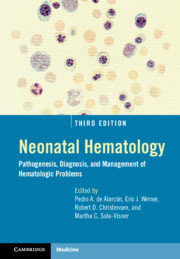Book contents
- Neonatal Hematology
- Neonatal Hematology
- Copyright page
- Contents
- Foreword
- Preface
- Contributors
- Section I Developmental Hematology
- Section II Bone Marrow Failure and Immune Disorders
- Section III Erythrocyte Disorders
- Section IV Platelet Disorders
- Section V Leucocyte Disorders
- Chapter 16 Eosinophils and Neutrophils
- Chapter 17 Functional Phagocyte Disorders in the Neonate
- Section VI Hemostatic Disorders
- Section VII Neonatal Transfusion Medicine
- Section VIII Neonatal Oncology
- Section IX Miscellaneous
- Index
- Plate Section (PDF Only)
- References
Chapter 16 - Eosinophils and Neutrophils
from Section V - Leucocyte Disorders
Published online by Cambridge University Press: 30 January 2021
- Neonatal Hematology
- Neonatal Hematology
- Copyright page
- Contents
- Foreword
- Preface
- Contributors
- Section I Developmental Hematology
- Section II Bone Marrow Failure and Immune Disorders
- Section III Erythrocyte Disorders
- Section IV Platelet Disorders
- Section V Leucocyte Disorders
- Chapter 16 Eosinophils and Neutrophils
- Chapter 17 Functional Phagocyte Disorders in the Neonate
- Section VI Hemostatic Disorders
- Section VII Neonatal Transfusion Medicine
- Section VIII Neonatal Oncology
- Section IX Miscellaneous
- Index
- Plate Section (PDF Only)
- References
Summary
Eosinophilia in neonates is identified when the blood concentration of eosinophils exceeds the upper reference range limit. To avoid the potential pitfall of laboratory or technician error, perhaps the definition should be two subsequent eosinophil counts above the upper reference limit. The 95th percentile for blood concentration of eosinophils increases slightly over the first month following birth. Initially a count ≥1,200/µL would exceed the upper range, and by about four weeks a count of above 1,500/µL would exceed the upper limit [1]. This latter value is similar to that generally used to define eosinophilia in adults [2]. Adults with persistent eosinophilia are well advised to have the situation evaluated, because an association has been seen between persistent eosinophilia and end-organ damage [2]. Some adults with persistent eosinophilia have elevated blood Interkeukin-5 (IL-5) concentrations [3]. Some with hypereosinophilic syndrome have an eosinophilic leukemia involving a translocation in the tyrosine kinase gene [4].
- Type
- Chapter
- Information
- Neonatal HematologyPathogenesis, Diagnosis, and Management of Hematologic Problems, pp. 261 - 278Publisher: Cambridge University PressPrint publication year: 2021

